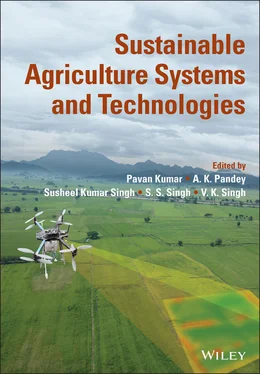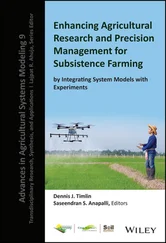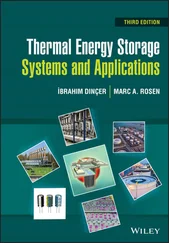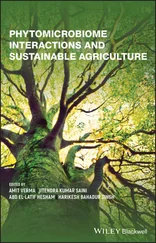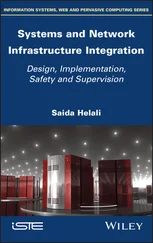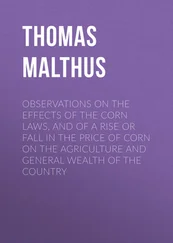Sustainable Agriculture Systems and Technologies
Здесь есть возможность читать онлайн «Sustainable Agriculture Systems and Technologies» — ознакомительный отрывок электронной книги совершенно бесплатно, а после прочтения отрывка купить полную версию. В некоторых случаях можно слушать аудио, скачать через торрент в формате fb2 и присутствует краткое содержание. Жанр: unrecognised, на английском языке. Описание произведения, (предисловие) а так же отзывы посетителей доступны на портале библиотеки ЛибКат.
- Название:Sustainable Agriculture Systems and Technologies
- Автор:
- Жанр:
- Год:неизвестен
- ISBN:нет данных
- Рейтинг книги:5 / 5. Голосов: 1
-
Избранное:Добавить в избранное
- Отзывы:
-
Ваша оценка:
- 100
- 1
- 2
- 3
- 4
- 5
Sustainable Agriculture Systems and Technologies: краткое содержание, описание и аннотация
Предлагаем к чтению аннотацию, описание, краткое содержание или предисловие (зависит от того, что написал сам автор книги «Sustainable Agriculture Systems and Technologies»). Если вы не нашли необходимую информацию о книге — напишите в комментариях, мы постараемся отыскать её.
A robust treatment of traditional and new techniques in sustainable agriculture Sustainable Agriculture Systems and Technologies,
Sustainable Agriculture Systems and Technologies
Sustainable Agriculture Systems and Technologies — читать онлайн ознакомительный отрывок
Ниже представлен текст книги, разбитый по страницам. Система сохранения места последней прочитанной страницы, позволяет с удобством читать онлайн бесплатно книгу «Sustainable Agriculture Systems and Technologies», без необходимости каждый раз заново искать на чём Вы остановились. Поставьте закладку, и сможете в любой момент перейти на страницу, на которой закончили чтение.
Интервал:
Закладка:
1.2 Growth of Agriculture in India
India is a leading producer of food grains, milk, wool, and other agricultural products. But what is the situation at present and how has India become what it is today, the journey to achieve this position was not a child's play. It began in the 1960s with the advent of the green revolution. During the independence period, India was left with own national governance and food insecurity. We were importing rice and wheat to feed the starving population. In 1966, India was the leading importer of rice and wheat. This was the time of introduction of green revolution. Introduction of dwarf wheat variety, subsidies on fertilizers, irrigation expansion, procurement at minimum support price, and chemicals for crop protection were done to increase the production (Mandal et al. 2020; Pandey et al. 2015). And the improved package of practice actually increased the production manifold. In 11 years, India’s wheat production increased 205% and rice production increased 72% ( Table 1.1) bringing India among the leading exporters at the global level in 1977–1978. The productivity (kg/hectare) increased 79% in wheat between 1966–1967 and 1977–1978, which was a record increment. The increase in rice productivity (kg/hectare) was 51% between 1966 and 1977. Since then, the production of wheat has but rice has not seen a setback. Area under wheat grew at an annual rate of 1.68 while production speeded up with Compound Annual Growth Rate (CAGR) of 4.3. Wheat has been a winner in green revolution with record increase in production and ensuring that the country is food secure. Area under rice grew at an annual rate of 0.55 while production speeded up with CAGR of 2.45.
Table 1.1 Percentage change in area production and productivity of wheat and rice in India.
Source : Indiastat.com,www.fao.org/faostat.
| Year | Area | Production | Productivity | |||
|---|---|---|---|---|---|---|
| Wheat | Rice | Wheat | Rice | Wheat | Rice | |
| 1965–1966 | 17.7 | 13.4 | 29.6 | 8.4 | 10.3 | −4.4 |
| 1977–1978 | 70.7 | 13.6 | 205.5 | 72.2 | 79.0 | 51.7 |
| 1989–1990 | 9.5 | 4.7 | 57.0 | 39.7 | 43.3 | 33.4 |
| 2001–2002 | 12.1 | 6.5 | 46.0 | 26.9 | 30.2 | 19.1 |
| 2013–2014 | 15.7 | −1.7 | 31.7 | 14.3 | 13.9 | 16.2 |
Wheat and rice are among the staple food of the country. Apart from this the government of India procures wheat and rice at Minimum support price and distributes it to the below poverty line population at subsidized price under National food security programme (Bisht et al. 2014; Singh et al. 2013; Tomar et al. 2014; Yadav et al. 2014). It is known that wheat and rice have a lion's share in procurement under Minimum Support Price. This has led to cereal dominance in food grain production. Per capita availability of food grains has shown increase in rice, wheat, and cereals, while it has declined in the case of gram, pulses, and other cereals ( Figure 1.1). This reveals that the advent of green revolution has shifted India from food insecure to food secure country. This raises up a question that whether being food secure ensures zero hunger?
1.2.1 Role of Agriculture in Nutrition
Agriculture plays a pivotal role in nutrition (Kadiyala et al. 2011). Agriculture provides the major food items required for the balanced dietary intake. As already discussed in the above section, India has made significant growth in agricultural production indicating that the availability of food is not a constraint in ensuring nutrition. But is this the only way through which agriculture ensures nutrition security? Nutrition security has three dimensions – access to adequate food, care and feeding practices, and sanitation and health (UNSCN). Here, the emphasis is on access to adequate food. The access to adequate food comes from the ability to pay for the demand of food. Source of livelihood here plays an important role in this ability to purchase apart from the subsidized food grains obtained from the NFSA. In 2020, agriculture employed around 58% of the Indian population and was the primary occupation of the country (IBEF 2021). In monetary terms, the Rs.19.48 lakh crores of Gross Value Added (GVA) was for agriculture, forestry, and fishing in 2020. Thus, a major source of income for a major section of Indian population. The year 2014 was recognized as the year of family farming emphasizing the role of agriculture in food and nutrition security. Moving to the care and feeding determinant of nutrition security it can be covered under agriculture by ensuring crop diversity and development of bio‐fortified food grains which have higher nutritional content, diversification of cropping pattern in order to ease the availability of a variety of food items at local level. And for the third determinant a model named “Farming System for Nutrition” model was developed (Das et al. 2014). This model suggested the location‐specific nutrition focused agriculture encompassing the diet need and surrounding environment development. Thus, it can be seen that the upliftment of nutritional security revolves around agriculture.
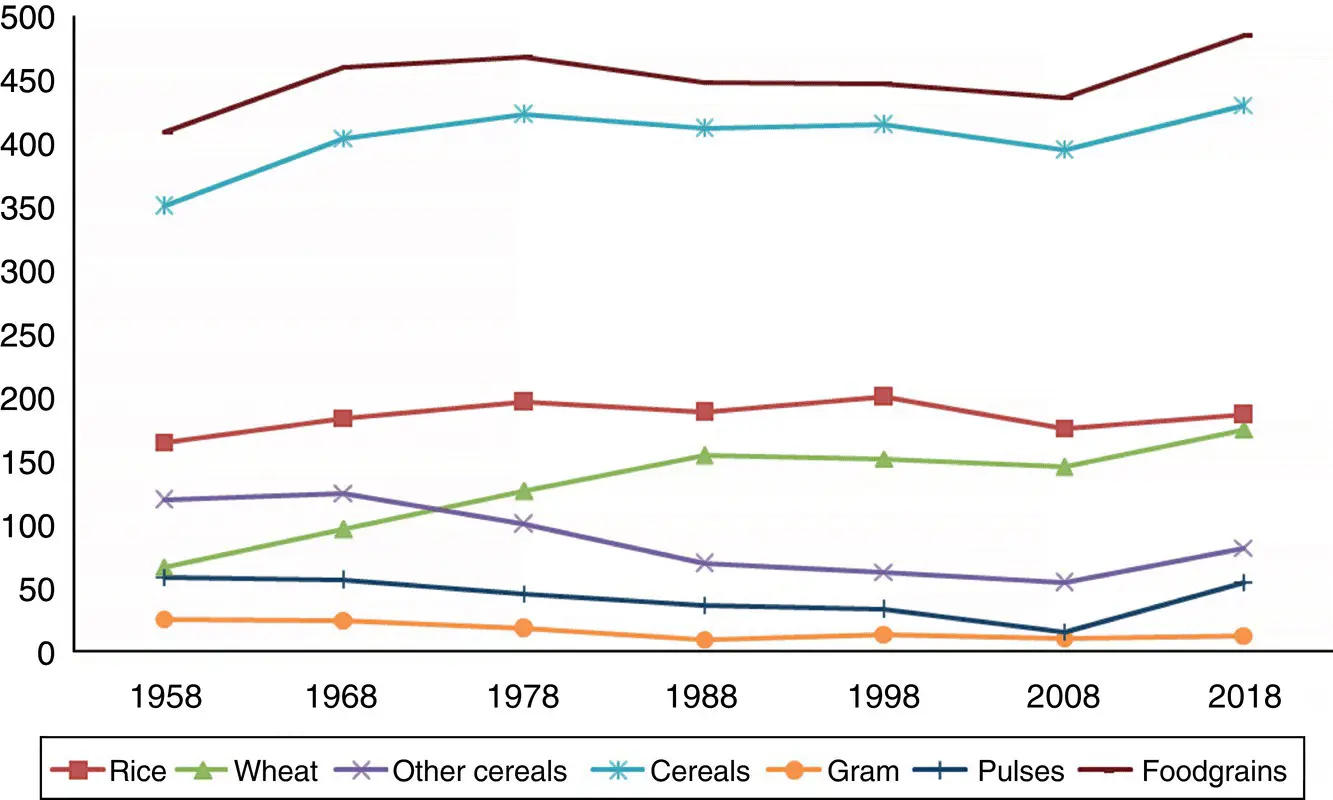
Figure 1.1 Per capita per day availability of food grains 1958–2018 in gm/day.
1.3 Dynamics of Under Nutrition in India
Hunger is measured considering children under five years who are under nourished, stunted, wasted, underweight, and under‐five mortality rate. Stunting means the percentage of children under five years who are stunted (height to age) is presented in Figure 1.2a from data obtained from National Family Health Survey (NFHS) 4. It shows that the highest prevalence of stunting is seen in Bihar, Uttar Pradesh, Jharkhand, Meghalaya, and Madhya Pradesh with more than 40% of children stunted, while Kerala, Goa, and Tripura have less than 25% of children stunted. Lessons can be taken from these states to improve the status in other states. Also, regional disparities were observed with higher percentage of stunting in rural area as compared to urban area. This is subject to the reasons that sanitation, antenatal care, and literacy are higher in the urban side. This means, emphasis on improvement of these parameters can help uplift the children from malnutrition.
Child wasting means low weight for height and indicates the acute food shortage or prevalence of disease in children (UNICEF). As per NFHS 4 Jharkhand, Gujarat, Karnataka, Madhya Pradesh, and Maharashtra, more than 23% of children are wasted ( Figure 1.2b), while Mizoram and Manipur have less than 10% wasted children. The reasons can be similar to the reasons of stunting. There is 50% chance that a stunted child will also be wasted. The urban rural divide is prevalent in this case too. Hunger also leads to underweight children and if prolonged it leads to mortality of children. As seen in Figure 1.2c, in Madhya Pradesh, Jharkhand, and Bihar more than 40% of children are underweight, while Manipur, Mizoram, and Sikkim have less than 15% underweight population of children under five years. This shows strong association between stunting, wasting, and underweight of children as Madhya Pradesh, Jharkhand, and Bihar have the highest prevalence of all these parameters. Under five infant mortality is highest in Uttar Pradesh, Madhya Pradesh, and Chhattisgarh, i.e. more than 60 deaths per 1000 lives ( Figure 1.2d). This reveals that Madhya Pradesh, Bihar, Uttar Pradesh, and Jharkhand have the highest level of malnourishment in India. Combining all the four parameters, we see that Madhya Pradesh, Bihar, Uttar Pradesh, and Jharkhand have the highest level of undernourishment in India. An insight into the economy of these states shows that Madhya Pradesh has 62% of labor force participation in agriculture and agriculture contributes 45% to the Gross State Value Added (GSVA) (Madhya Pradesh Budget Analysis 2019–20 ). Uttar Pradesh, the most populous state of India (17.11%) is the leading producer of food grains in India (Agricultural Statistics at a Glance 2018). Jharkhand is a rural state with 76% of its population living in rural area. And almost 49% of its population lives below poverty line. Bihar has 23% of its GSVA to the state's economy by agriculture (Bihar Budget Analysis 2019‐20). Apart from this out of total labor force the casual labor force of Bihar is 32.2%, Jharkhand 23.6%, Madhya Pradesh 28.2%, and Uttar Pradesh 21.3% and they are not able to find job after COVID‐19 outbreak. Percentage of population below poverty line of Bihar is 33.7%, Jharkhand 36.7%, Madhya Pradesh 31.7%, and Uttar Pradesh 29.4% and Uttar Pradesh has 17.12% of population, while Bihar, Madhya Pradesh, and Jharkhand comprise of 9, 6, and 3% of population, i.e., 35% of the population of India. These states are mainly agriculture dependent making the population more vulnerable. Madhya Pradesh and Uttar Pradesh being highly populous states in spite of having high number of beneficiaries under Integrated Child Development Scheme are still among the poor performers. This implies that unequal distribution of income might be the reason that despite economic growth and food production, prevalence of hunger is there.
Читать дальшеИнтервал:
Закладка:
Похожие книги на «Sustainable Agriculture Systems and Technologies»
Представляем Вашему вниманию похожие книги на «Sustainable Agriculture Systems and Technologies» списком для выбора. Мы отобрали схожую по названию и смыслу литературу в надежде предоставить читателям больше вариантов отыскать новые, интересные, ещё непрочитанные произведения.
Обсуждение, отзывы о книге «Sustainable Agriculture Systems and Technologies» и просто собственные мнения читателей. Оставьте ваши комментарии, напишите, что Вы думаете о произведении, его смысле или главных героях. Укажите что конкретно понравилось, а что нет, и почему Вы так считаете.
